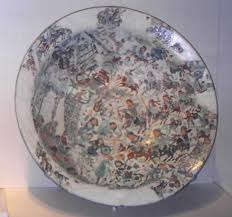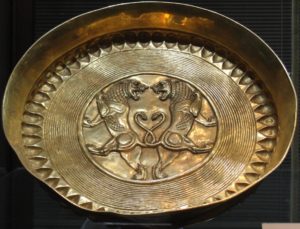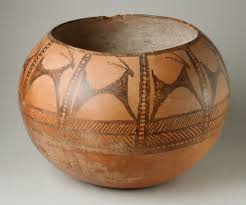Persian Pottery is one of the oldest Persian art forms, and examples have been unearthed from burial mounds (Tappeh), dating back from the 5th millennium BC. The earliest pottery extant is supposed to be a metallic lustered ware, which was probably produced several centuries before our era.
Persian Ceramics
Influenced by techniques already practiced in conquered territories, Persian potters developed new forms and styles to produce the fine wares that characterize Persian ceramics. Because refined wares were mostly destined to serve and decorate the homes of the wealthy, or for export, this industry received great patronage and support.

It is certain that the Arabs, after their invasion of Persia in A. D. 636, learned there and carried into Spain the art of making the lustered ware now known as Hispano-Moresque. In Persia, fragments have been found among the debris of the older ruins of Rhages, which was finally and totally destroyed in 1250 B. C.
Persian Pottery Art
The early painting was mainly used to decorate manuscripts and versions of the Holy Koran, though some 13th-century pottery found near Tehran indicates an early, unique Persian style of art.

The 11th century brought dramatic changes to the ceramic industry, influenced by Chinese porcelain ware. For a time Persian potters had tried to imitate the Chinese potter’s porcelain ware, but they were unsuccessful because they lacked kaolin, a fine clay used for the production of porcelain.
Achaemenian Art
Rayy ceramics exhibit evidence of the Chinese inspired pottery technique known as sgraffito. Sgraffito is a technique where two glazes are applied to the pottery and then a design is engraved into the glaze. The main colors used in the decoration are generally green and yellow and the subjects usually are representations of birds.

Achaemenian art was capable of influencing that of others and its impress is most noticeable in the early part of India, with which it probably came into contact through Bactria. Silver-work, glazing, goldsmiths’ work, bronze casting, and inlay work are all well represented in Achaemenian art.
Persian Pottery Artists
During the 7th century, the influx of Arab Muslims encountered a fully developed civilization with deep artistic traditions. The Arabs soon adapted to these traditions and eventually incorporated it into their own art form.

Continued expansion of Arabian influences into eastern Asia resulted in the large-scale trade of information and technology between China and the Mediterranean, along what is known as the Silk Road.
Pottery in recent Persia still attempts fine-grained earthenware but with very little success. On objects of a recent date, the glaze is more vitrified the colors less pure and blended in the glaze, and the designs poorly executed. The usual color of these pieces, azure blue on a white ground, is known as blue and white.